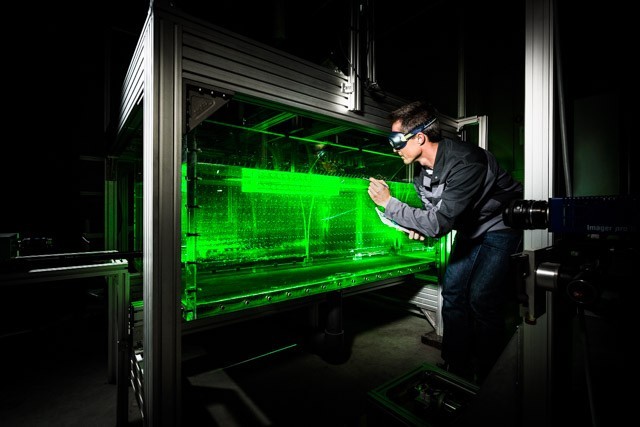High Temperature Flows
Fields of activities
Numerical simulations of metallurgical melting processes including magnetohydrodynamics and bubble or particle motion, physical modeling of melts with water models, laser flow measurement techniques

Water model of a strip caster (photographer: Martin Braun)
Areas of research
The knowledge of flows during refining and casting of e.g. steel, copper and aluminium in metallurgical reactors (converter, ladle, tundish and casting mould) is crucial for the optimization of the quality of semi-finished and final products. The options of flow measurements in metallurgical mels are very limited due to the high temperatures. Therefore flow and heat transfer phenomena have to be investigated using physical and numerical models.
Water models of metallurgical reactors
The kinematic viscosities of metal melts and water are in the same area of magnitude and for this reason their flow characteristics are almost equal. Therefore, an investigation of melts using water models is possible. The IOB has different water model test stands available.
- Tundish, casting mould, ladle and converter
- Visualisation of fluid flow with laser light sheet technique
- 3D measurement of turbulent fluid flow fields with DPIV and LDA Measurement of temperature and concentration fields with LIF
- Retention time measurement and analysis of mixing processes
- Determination of particle distribution and precipitation curves using Coulter Counter
- Fluid flow optimisation by passive fluid flow manipulation
- Measurement of water level movements with ultrasonic sensors
Numerical simulation
In parallel to flow investigations using physical models, numerical simulations using CFD are carried out. To improve the accuracy of the calculations, the simulations are first conducted for water flows and the boundary conditions are validated against very accurate laser optical measurements. Only after this validation step the simulations are conducted for multi-phase, non-isothermal metal melts.
- Simulation of fluid flow of melts in metallurgical reactors (multi-phase, non-isothermal)
- Simulation of mixing process during ladle changes
- Electroslag Remelting (ESR) and Vacuum Arc Remelting (VAR)– magneto-hydrodynamic and thermotechnical phenomena
- Simulation of fluid flow as well as combustion and pyrolysis in aluminium melting furnaces
- 3D Simulation of the VAR process in non-axisymmetric geometries
Services
Research projects
Ongoing research projects
- FlexHybHeat: Process development for a hybrid heating concept for highly flexible and low-CO2 billet heating in electric steel mills (BMWK)
- HeatSteel — Development of a process model for a strip annealing line (progres.NRW)
- ZeroCO2Glas — Development of a novel hydrogen-fired glass melting furnace with the aim of a CO2-neutral container glass production (BMWK)
- COSIMa — CO2-neutraler Saint-Gobain Standort Herzogenrath Machbarkeitsuntersuchungen (progres.NRW)
Completed research projects
- Development of a novel simulation-based control system for the resource-efficient heating of forged parts (AiF ZIM)
- Metal crystallization on rotating cooling cylinders — Mechanisms and process model for the control of a high purification of metals using the example of aluminium (DFG)
- Development of a process for resource-efficient recycling of printed circuit board scrap by microwave pyrolysis in rotary kilns (AiF ZIM)
- Experimental and numerical investigations of the multiphase flow in the water model of a steel casting ladle as a basis for further development of the multiphase models in the flow simulation of metallurgical reactors (DFG)
- Influence of a rotating electrode on the droplet formation and the refining effect in the electroslag-remelting process (DFG)
- AMAP P5: Sustainable aluminium recycling: Efficient melting
- Numerical modeling of the momentum, heat and mass transfer in the Vacuum Arc Remelting process (Cooperation with VDM Metals)
- Process reduction and CO2 saving in the steel strip production through industrialization of the strip casting technology (BMBF)
- Process optimization of the double roller strip casting process by systematic distribution of the melt into the melt pool (DFG)
- Mathematical modelling of fluid induced Vessel motion in the AOD process (Cooperation with SMS Siemag)
- Numerical and experimental investigation of flow and particle movement in thin slab moulds (DFG)
- Use of numerical and physical simulation on multi-phase flows and particle separation in tundishes as a contribution to increased cleanness of steels (DFG)
- Simulation of the velocity and temperature distribution in tundishes with electric arc heating (DFG)
- Impulse, Heat and Mass Transport in Argon ESR Refining using Titanium as an Example (DFG)
- Simulation of flow, solidification and strip forming during the production of broad strip using the two-roll casting process (DFG)
- Numerical and experimental investigation of stationary and transient flows in tundishes (DFG)
